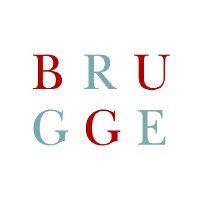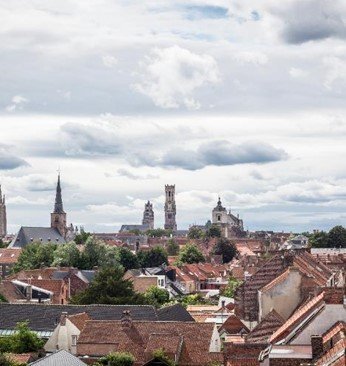- Welcome
- CRFS Description
- Living lab description
- Living: Innovation action plan
- Stories from the lab
- Lab festival
- The first experiment
- The second experiment
- The third experiment
- The fourth experiment
- The fifth experiment
- The sixth experiment
- Policy: Policy Action Plan
- Food System Dialogue
- Access history
- Members

CRFS Description
City of Bruges - Belgium
Region: Flanders - Province of West Flanders, City of Bruges is the capital
Surface area: 138 km²
Population (2021): 119.019
Population density (2021): 862 people per km²
Climate: moderate sea climate
UNESCO protected city centre
Challenges: sustainable urban development, climate adaptation/resilience and tourism
Local economy: Port of Zeebrugge, mechatronics, 'Handmade in Bruges', healthcare, IT
Field of excellence: The port of Zeebrugge is one of the main car handling ports in the world
Knowledge institutions: Katholieke Universiteit Leuven, VIVES University of applied sciences, HOWEST University of applied sciences
The major project objectives:
Enhance circularity and local food belts
Protect & preserve natural resources
Secure healthy and sustainable food
Stop food poverty and insecurity
Develop food culture and skillsopics included in the lab
Topics included in the lab:
Farm to fork aspects
Personalization of diets
(Care)-network aspects of the 65+ individual
Food technologies
Sustainable delivery system
Smart food related technologies at home
Bruges is the only regional Cities2030 partner in Belgium but has the ambition to share and multiplicate our outcomes with other cities in Belgium. In terms of living lab activities 4 partners (City of Bruges, Ruddersstove, Mintus and Vives) will be working closely together with many partners of the foodservice and care network in and around Bruges.
Although the Bruges region was already populated in Roman times, the city’s name appears for the first time in the 9th century, probably derived from the Old Germanic word ‘brugj’, which means ‘mooring’. Bruges has always had a special bond with the sea. After all, water played a crucial role in the city’s foundation. It was the place where several streams merged into a single river (the ‘Reie’), which flowed north into the coastal plain. This river was linked to the North Sea through a series of ‘tidal channels’, guaranteeing the city’s future welfare and prosperity.
Demographics:
Of the 118,187 inhabitants as of January 1, 2017, 57,406 were men and 60,781 women. There were then 22,359 Bruges residents in the age group from 0 to 19 years, 68,412 in the age group from 20 to 64 years, and 27,416 in the age group of 65 years and older.
A favourable location:
In the early Middle Ages, Bruges developed into an international and bustling trading city with its own port, made possible by its favourable location and connection with the sea. At the same time, the fortified town became a powerful political stronghold, thanks to the presence of the Flemish Counts, who ruled over the County of Flanders. In the 13th century, Bruges was the leading trade centre of northwestern Europe. Merchants from all over Europe settled in the city and the world’s first ever stock exchange (‘Beurs’ in Dutch) was founded in Bruges. These market activities took place on a square in front of the house owned by a powerful family of brokers, the Van der Beurse family. As a result, their name became linked for all time with this kind of financial institution. In spite of the typical medieval maladies, the citizens of Bruges prospered, and soon the city developed a magnet-like appeal. Around 1340, the inner city numbered no fewer than 35.000 inhabitants.
The golden century:
The success continued and in the 15th century, Bruges’ golden century, business was better than ever before. This was due to the fact that from the end of the 14th century, Flanders was part of the realms of the dukes of Burgundy. They expanded their presence in Bruges, turning the city into a cultural and commercial centre that was second to none. In addition to the traditional broadcloth, numerous new luxury goods were now produced and sold. Famous painters such as Jan van Eyck and Hans Memling – the great Flemish Primitives– found their creative niche here. The fine arts flourished, and in addition to wonderful churches and unique ‘nation houses’ (embassies), the monumental town hall was also completed. Bruges’ success seemed imperishable.
Decline:
The sudden death in 1482 of the much loved ruler, Mary of Burgundy, heralded the start of new and less fortunate times for the city. The relationship between the citizens of Bruges and their lord, the widower Maximilian of Austria, turned sour. The Burgundian court left the city, with the international traders following in its wake. To make matters worse, Bruges’ connection with the sea quickly silted up. The Golden Age had passed and was succeeded by long eras of war and regime change. By the time Belgium gained independence (1830), Bruges was a poor and impoverished provincial city. Strangely enough, its fortunes were changed for the better by the writing of a novel
Revival
In Bruges la Morte (1892), Georges Rodenbach aptly describes Bruges as a somewhat sleepy, yet extremely mysterious place. In particular, the 35 pictures that were included in the book for illustrative purposes sparked his readers’ curiosity. Soon Bruges’ magnificent patrimony was rediscovered and its mysterious intimacy turned out to be its greatest asset. With great care, Bruges took its first steps into tourism. The age-old desire to be connected with the sea resulted in the development of a new international seaport at the end of the 19th century, which was given the name of Zeebrugge.
Bruges today:
During the First World War, Zeebrugge became the operational base for the German submarine fleet, coordinated from their headquarters on the Market Square in Bruges. Fortunately, both world wars left the historic city centre virtually unscathed, making Bruges increasingly appealing to visitors and culture-lovers alike. Its beauty and attraction was confirmed in 2000, when UNESCO classified the entire medieval inner city as a world heritage site. The rest, as they say, is history.


External drivers and trends of change that may impact the future CRFS:
| Dimensions | Drivers | Trends | Impacts |
| Politics | Russo-Ukranian war | Increasing energy prices | Food production process getting more expensive |
| Economy |
Closing nuclear power plants in Belgium COVID-19 |
Increasing energy prices Lower consumption and spending power |
Food production process getting more expensive Less meals delivery for people not really depending on it - more meal deliveries reaching people in need |
| Cultural | Bruges is famous for old traditional food such as beers, chocolate, hams, sausages, and cheeses | There might be a trend to increasingly appreciate older traditional Belgian food | More opportunity for new artisanal production |
| Society |
Belgians spend more on food than the Dutch. Solidarity and equality |
Belgians eat local, so the local food economy thrives Evolving traditional and modern gender roles in private life and working life |
The ability for food innovative producers to benefit more from advantages through economy of scale
More equal and inclusive social fabric |
| Technology | Route planning software | Food delivery increasing for some segments | In this emerging niche, more mergers are likely to happen over time to increase efficiency to delivery in termof economy of scale (e.g. bikers with more deliveries at once in same area) |
| Environment |
People in Bruges might wish to eat more environmently friendly Awareness of environmental degradation and impact on life of climate change |
Climate change Willingness to reduce environmental degradation, to safeguard earth systems and to improve the status of the environment |
More companies might consider green delivery better resourced and targeted waste management local policies |
| Values | People in Bruges might wish to eat more healthy | Globalization of food culture and better comparative options | Food producers of less healthy food are likely to face more pressure |
Current state analysis and future vision 2030
Based on brainstorming sessions with partners and stakeholders in the current state, it is opportune to improve on the following areas
- Farm to fork aspects
- Nutritional technologies
- (Care-)network aspects of the 65+ individual
- Personalization of diets
- Sustainable delivery system
- Smart food related technologies at home
In the future, we wish to improve on:
- Farm to fork aspects
- Nutritional technologies
- (Care-)network aspects of the 65+ individual
- Personalization of diets
- Sustainable delivery system
- Smart food related technologies at home

